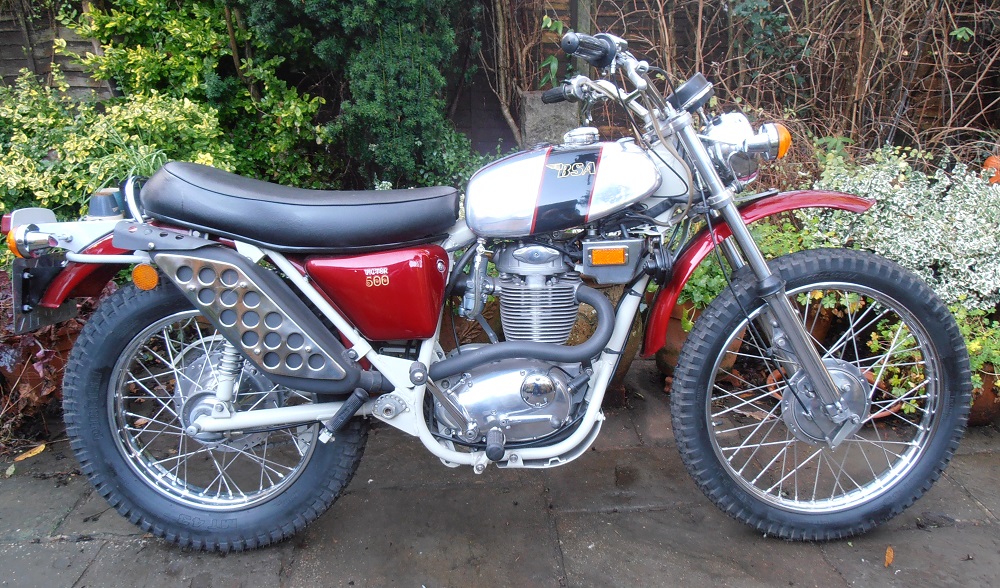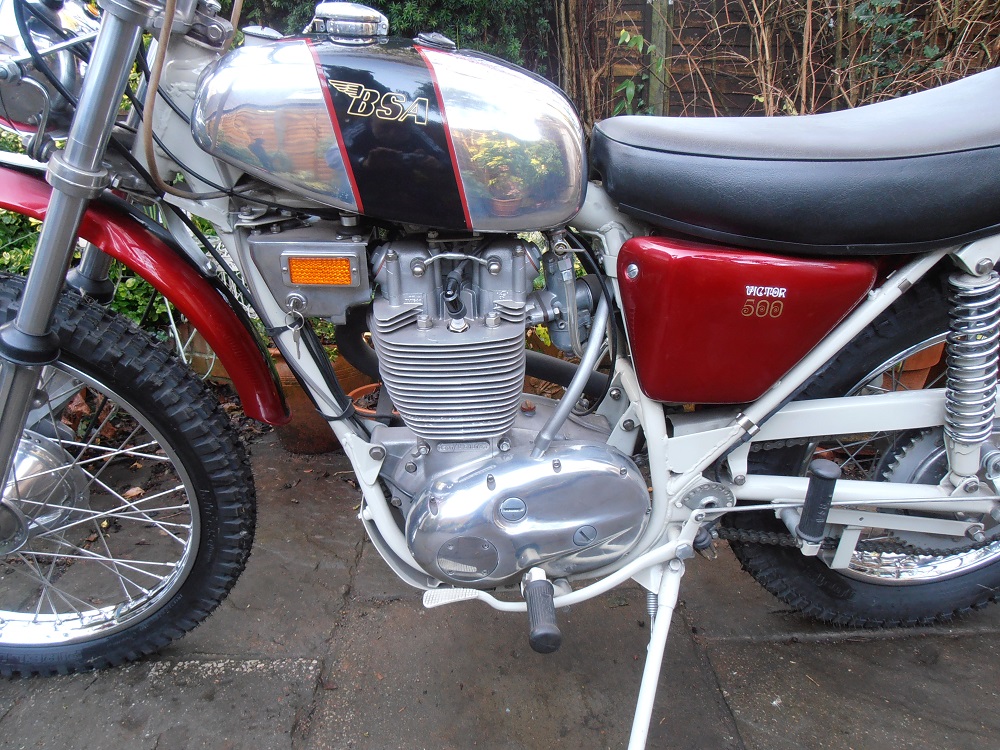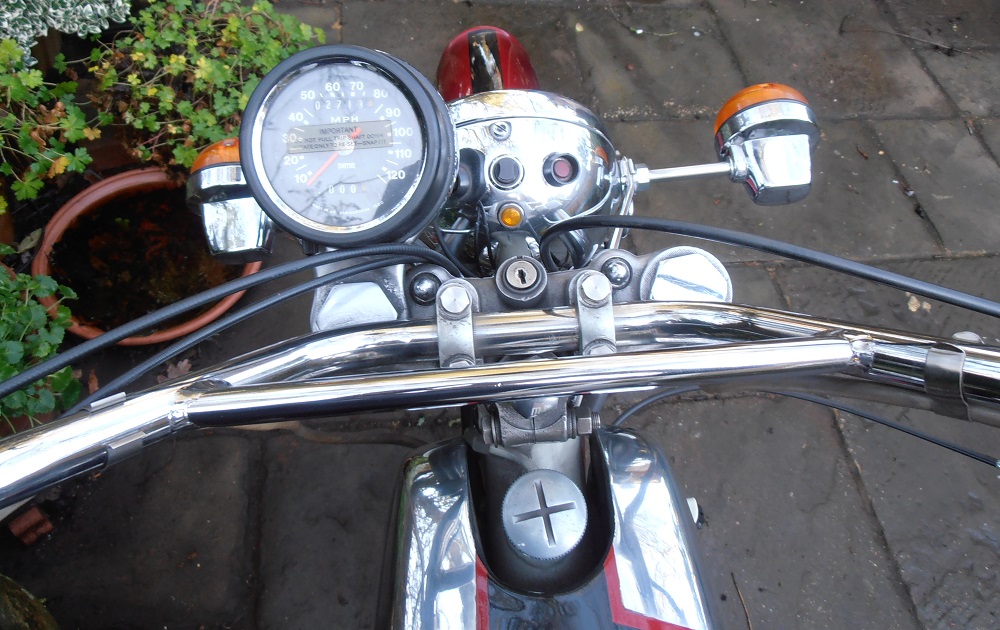
The B50 was the final development of the range of unit construction single cylinder motorcycles produced by BSA that started with the 250 cc C15 in 1958. The B50 was first produced in 1971 and continued until the demise of the BSA Group in 1973. It was produced in three distinct models:
- B50SS (‘Street Scrambler’ Gold Star)
- B50T (Victor Trail)
- B50MX (Victor Motocross)
The B50SS was basically the road going version of the B50, with the B50 Trail intended for dual on- and off-road use, whereas, the B50MX was intended for motocross only. The B50SS and B50T were only produced in 1971 and 1972 while the B50MX was produced in all three years.
The B50 engine was based on the 1970 B44 engine with similar roller bearing big-end but with bore and stroke changed from 79 mm x 90 mm to 84 mm x 90 mm with compression ratio changed from 9.4:1 to 10:1. The B50 engine was beefed up by using two separate bearings on the left-hand end of the crankcase; an inner roller bearing and an outer ball bearing.
One of the other main changes to the B50 engine was in respect of the way the engine breathed. In the B44 and previous engines, breathing was achieved via a timed hole in the camshaft allowing air to flow between the crankcase, the inner timing case and then via a small pipe near the clutch lever to the atmosphere. With the larger displacement of the piston in a B50, this was no longer consider to be adequate. Instead, the B50 engine breathing was achieved by deleting the oil seal on the left-hand end of the crankshaft allowing air flow through the bearings between the crankcase and the primary chaincase and then via an outlet pipe in the top of the chaincase to the atmosphere.
Both the B50SS and B50T were fitted with a large metal lozenge shaped silencers with a high level output. This was fitted with a perforated stainless steel heat shield to protect the pillion riders right-leg from heat. In contrast, the earlier B50MX’s were fitted with a simpler megaphone silencer although this was changed in 1973 to a rather hideous double silencer arrangement.
The B50SS was fitted with a steel petrol tank originally holding 2 gallons but was then changed to a larger 3 gallon version. Both the B50T and B50MX were fitted with aluminium petrol tanks with Monza caps, the former being very slim and holding 1 gallon and the latter holding 2 gallons. They were all held in place on the frame using the normal BSA centre bolt arrangement.
The other main change introduced with the B50 was a new frame that was designed to hold the engine oil rather than in a separate oil tank as was the previous practice. This so-called, Oil-in-Frame (OIF) design was a product of the BSA Group’s much maligned Unberslade Hall research centre. The frame was coupled to Marzocchi type telescopic forks and Girling twin rear shock absorbers and all the B50 wheels used so-called conical wheel hubs made from Aluminium. Both wheels on the B50SS were 18″ in diameter while the off-road B50T and B50MX used a narrow 20″ front wheel.
The metal side panels on either side of the B50SS and B50T hide the air filter box on the left-hand side and the battery tray on the right-hand side. The air box contains a plenum chamber and a cylindrical paper element filter underneath the side panel. The arrangement for the B50MX was slightly different. This did not use a battery and therefore no battery carrier was fitted. The B50MX was fitted with a pair of fibre glass side panels between which was mounted an air filer box containing a paper filter.
For the B50 road going models, it was not possible to mount the main electrical component sunder the saddle and so these ere contained in an electrical box mounted just below the front of the petrol tank in front of the engine. This contained the Zener diode, a 2MC capacitor, ignition coil, rectifier, flasher unit and ignition switch. In order to try to prevent vibration from the engine damaging it, the electric frame was suspended from the frame by isolastic mounts.
The road going B50’s were fitted with indicators front and back which were operated via OIF Lucas handlebar switch units. These were of diecast aluminium and incorporated the levers for the clutch and front brake. The headlight unit incorporated warning lights for the main beam, indicators and oil pressure. It also incorporated a rotary switch for selecting the main headlight beam. Both the B50T and MX used a high level front mudguard bolted to the lower steering yoke via a long bracket. In contrast, the B50SS used a low level front mudguard attached to the forks via a rather insubstantial wire brackets. The rear mudguard on all the B50’s was essentially the same although both mudguards on the B50MX were stainless steel.
My B50T Restoration
My 1971 B50T was in relatively poor, non-running condition when I bought it. It was given a full nuts and bolt restoration with the frame powder coating in the correct cream colour and with the mudguards and side panels professionally painted in Candy Red. The original candy paint used a silver basecoat but, as others have done, I chose a gold basecoat for this restoration as it produced a warmer colour. The aluminium 2 gallon tank was in very battered, dented condition when I bought the bike and looked unsalvageable. However, I sent it off to Pickering and Motorcycle Dent Removal to see what they could do. A few weeks later, I was then completely amazed when it came back almost as good as new!
The B50 engine was completely rebuilt with new bearings and seals throughout. The cylinder was re-bored with a new piston and the valves and springs were all replaced and the seats recut. The cylinder head, barrel and crankcases were all vapour blasted to clean them. The engine cases were then re-polished after removing all the scratches and damage using an electric sander and suitable grades of paper.
Both wheels were completely rebuilt with new rims and spokes from Central Wheel Components. The main issue was the known unavailability of 20″ front tyres at the time which forced a change to a 21″ tyre. The original conical hubs were painted silver during manufacture by BSA as this was much cheaper for them than polishing. Despite this, I decided to polish both hubs as this is the way BSA should have done it.
Both fork stanchions were replaced as were the fork seals and scraper seals. These Marzocchi type forks do not use internal bushes with the fork lower legs sliding directly up and down on the stanchions. Despite there being no means available for compensating for wear in the moving forks, non of the fork lower legs on either my B50’s or B25’s showed any signs of free play and needed to be replaced.
The wiring harness and switches on my B50T were in reasonable condition and, apart from a good clean and minor repairs, were perfectly useable. However, the electric box needed to be completely overhauled. There were three versions of the mounting arrangement for the electric box during the two years the B50SS and B50T were produced. My B50T used the final version which made use of 3 x isolastic mounts to mount the box on to the frame in order to isolate it from the engine vibration. Mine were in poor condition but, fortunately, new ones are still available from the original manufacturer. The electric box on a B50 (and 1971 B25) is an appalling arrangement especially with it mounted just above the hottest part of the engine (exhaust port) which did nothing for its reliability. It is also a nightmare to deal with if one of the many electrical components inside it fails requiring the box to be removed and then completely dismantled.
Although my B50T was relatively expensive to restore, the re-chroming needed was relatively modest and was limited to the headlight shell, rear shock absorber springs, pillion passenger grab rail, handlebars and kickstart. Overall, it was not a difficult bike to restore with most parts being readily available from the main Suppliers. Although I think my B40WD is one of the most handsome BSA bikes I own, the B50T comes a close second especially with its very beefy 500 cc single cylinder engine.




 BSA B50T Specifications
BSA B50T Specifications
- Engine: Single cylinder, OHV, 2-valve, 4-stroke
- Starting: Kickstart only
- Capacity: 499 cc
- Bore/Stroke: 84 x 90 mm
- Compression Ratio: 10:1
- Max Power: 34 hp
- Carburettor: AMAL 930 carburettor
- Cooling: Air cooled
- Lubrication: Dry sump
- Ignition: Coil and contact breaker points
- Transmission: 4 speed foot shift
- Final Drive: Chain
- Front Suspension: Coil spring and hydraulically damped
- Rear Suspension: Coil spring and hydraulically damped
- Front Brake: 6 inch drum single leading shoe
- Rear Brake: 7 inch drum single leading shoe
- Frame: Oil-in-Frame (OIF)
- Wheel Base: 54 inch
- Seat Height: 32 inch
- Front Tyre: 3.00 x 20 inch
- Rear Tyre: 4 x 18 inch
- Ground Clearance: 7.5 inch
- Dry Weight: 135 kg
- Fuel Tank: 2 gallons
- Oil Tank: 4.75 pints
BSA B50 Parts Suppliers
Some B50 spare parts are relatively easy to get hold of with many good suppliers easily found on the internet. Two of the larger suppliers of BSA parts are Burton Bike Bits and Dragonfly Motorcycles.
14,389 total views, 8 views today

